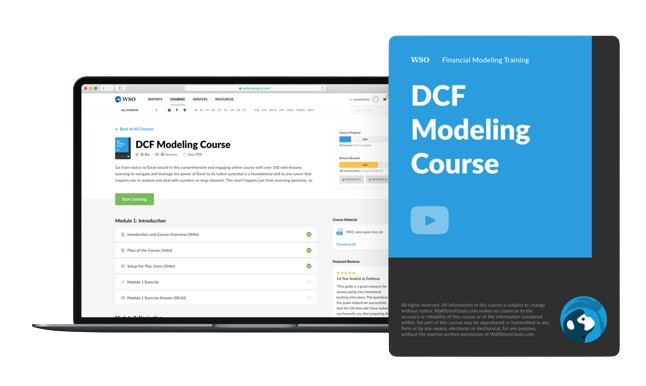Discounted Cash Flow DCF Formula
Refers to a complicated means to value a company over a while using cash flows
What Is Discounted Cash Flow (DCF)?
The term "discounted cash flow" (DCF) refers to a method of valuation that calculates an investment's value based on its anticipated future cash flows.
The Discounted Cash Flow is a complicated means to value a company over a while using cash flows. Using estimates of how much money investments will make in the future, DCF analysis seeks to evaluate the value of investment now.
Using estimates of how much money an investment will make in the future, DCF analysis seeks to evaluate the value of an investment today.
It can aid those who are trying to decide whether to purchase securities or a firm. Business owners and managers can use discounted cash flow analysis to help them make decisions about operational and capital budgets.
It involves various steps to achieve a goal, and it is mostly calculated in MS Excel - we will cover that too, as it serves as a practical means to the article and will help you at work. Its method has several pros and cons, as it is not a stand-alone means of valuation.
DCF is often contrasted with Net Present Value, and this appears in common interview questions, which we will also cover. It comes with odd terms like "terminal value" and "WACC," which play a significant role in your end valuation.
Before we get into the nitty-gritty, let's go over certain terms that will appear later on.
Understanding Discounted Cash Flow
Let us now understand some terms before we understand discounted cash flows.
1. WACC
A company's Weighted Average Cost of Capital (WACC) measures its total cost of capital, including debt, common shares, and preferred shares. Each sort of capital's cost is multiplied by how much overall capital it makes up.
2. Terminal Value
Terminal Value refers to the present value of all the cash flows in your business at a future point instead of a present value. This calculator assumes a stable ("normal") rate of growth in perpetuity ("indefinitely").
Terminal value is used for many tools, but in our case, we use it in a DCF.
3. Equity Value
The term "market cap" also refers to equity value. You might have heard the term market cap when valuing companies or seen it on Google Finance or Bloomberg, but what is it?
It is equal to the share price multiplied by the total number of outstanding shares. This is important if a business owner wishes to acquire a sufficient equity value when selling their company.
4. Cash Flow
Refers to the quantity of money a business gets or transfers to its debtors in cash or cash equivalent. The liquidity condition of the business is frequently studied using cash flow analysis.
It provides a quick view of how much money is going into the company, where it is coming from, and how much is leaving.
5. Net Present Value
The difference between the present value of the cash flows at the project's needed rate of return and your original investment is known as the project's net present value.
6. EBITDA
EBITDA stands for Earnings before interest, taxes, depreciation, and amortization and is referred to as "EBITDA."
The above amounts are deducted from a company's total revenue to calculate the profit generated before taxes and other financial factors.
EBITDA may be useful for comparing organizations across industries or assessing a company with high-value costs that lower net earnings. As a result, most companies EBITDA data is now included in their monthly earnings reports.
Now that we've understood the various terms, let us look at discounted cash flow.
Discounted Cash Flow (DCF) is predominantly used to value a company today by forecasting its future cash flow.
Since investors are forward-looking, projecting a company's future cash flow will allow an investor to distinguish if a company is a bargain. Discounted cash flow takes many things into account, such as time value, risks, and impactful changes to the business earnings.
How to Calculate DCF?
The following section highlights the steps in constructing a DCF.
The first deals with forecasting the free cash flows, typically for five to ten years.
This is when you use a set of assumptions based on historical data to project how much the company will generate in cash in the next five to ten years.
2. Calculate the Weighted Average Cost of Capital
This is the discount rate you will use to bring all the future cash flows back to the present. (so to year zero) and the reason you need to do this discounting has to do with the Time Value Of Money.
This concept says that a sum of money today is worth more than a sum of money in the future because of things like being able to invest it and grow it over time.
To have an accurate representation, you must bring everything back to its present value.
3. Calculate the Terminal Value
After the forecasted period, say, five to ten years, the company does not just disintegrate, there's usually a life after that, and it keeps on going.
This means that after that forecasted period, you need to assume a value that's what's known as the terminal value, so it's the company's value after the forecasted period.
4. Discount the Cash Flows Back to the Present
That applies to the free cash flow and the terminal value you want to take back to year zero.
5. Get to a valuation
You're going to calculate the enterprise value and the equity value and eventually get to the implied share price.
How Does Discounted Cash Flow (DCF) Work?
As a result, a DCF analysis is helpful when someone is paying money now to obtain more in the future. Common uses also include Comparable Company Transactions and Precedent Analysis.
A discounted cash flow analysis uses a discount rate to determine the present value of anticipated future cash flows.
The primary advantages of a DCF model are numerous and extensive. It is comprehensive and contains all essential business presumptions that aid in calculating a company's intrinsic value. It doesn't employ a similar corporate analysis.
One significant advantage is that everything can be done using an existing Excel model. It may even be applied to calculate the internal rate of return while considering scenario and sensitivity analysis.
There are certain issues with the DCF Model. It has a lot of assumptions and is prone to errors. Some experts make it too complicated. When assumptions are altered, the model is sensitive.
Additionally, it disregards the relative valuations of competitors and takes the firm's worth. Finally, it has a strong reliance on terminal value. As a result, WACC encounters some calculating issues as well.
Discounted Cash Flow FAQs
In an unlevered DCF, the discounted rate, or WACC, represents the projected return on investment given the risk involved.
Since prospective rewards and risks are well related, the discount rate is a function of how risky the cash flows are.
The discount rate is the hurdle or minimal return threshold of an investment based on other investments with a similar risk profile.
Higher Discount Rate: A higher discount rate means that there is MORE risk, devaluing a company's cash flows.
Lower Discount Rate: Because there is LESS risk, a lower discount rate makes a company's future cash flows MORE valuable.
The weighted average cost of capital (WACC) is the appropriate discount rate to apply to an unlevered DCF.
Since FCFFs(Free Cash Flow to Firm) are the cash flows that equity and debt providers own, they align with WACC.
The WACC considers equity and debt capital providers when calculating the discount rate. This is often known as the cost of capital.
On the other hand, the appropriate discount rate for a leveraged DCF would be the cost of equity.
While WACC relates to Unlevered DCF, cost of equity relates to Levered DCF.
Firstly, the Discounted Cash flow calculates the company's inherent value. Secondly, the Comparable Company analysis, and thirdly the Comparable Acquisitions method.
The comparable company and acquisitions analysis calculates the company value at relative value. The DCF method uses cash flows to calculate its value, while the other uses similar acquisitions and metrics from comparable companies.
A company's enterprise value takes its stock, debt, and cash into the account. Enterprise value is a more complete method of appraising a company than equity value (or market cap). The enterprise value of a corporation accounts for its shares, debt, and cash.
A very basic formula for enterprise value is:
EV = market capitalization + common/preferred stock + minority interest + debt - cash and cash equivalents
A common question in interviews is, “What is the difference between NPV and DCF?” You will have to summarize this in a few short sentences, or an interviewer might want an expanded explanation. Either way, we will cover it here.
An ideal answer would be “NPV stands for net present value, which is the primary distinction between it and DCF. It compares the worth of money now to the value later on.
Discounted cash flow is known as DCF. It analyzes the investment and establishes its potential worth.




or Want to Sign up with your social account?